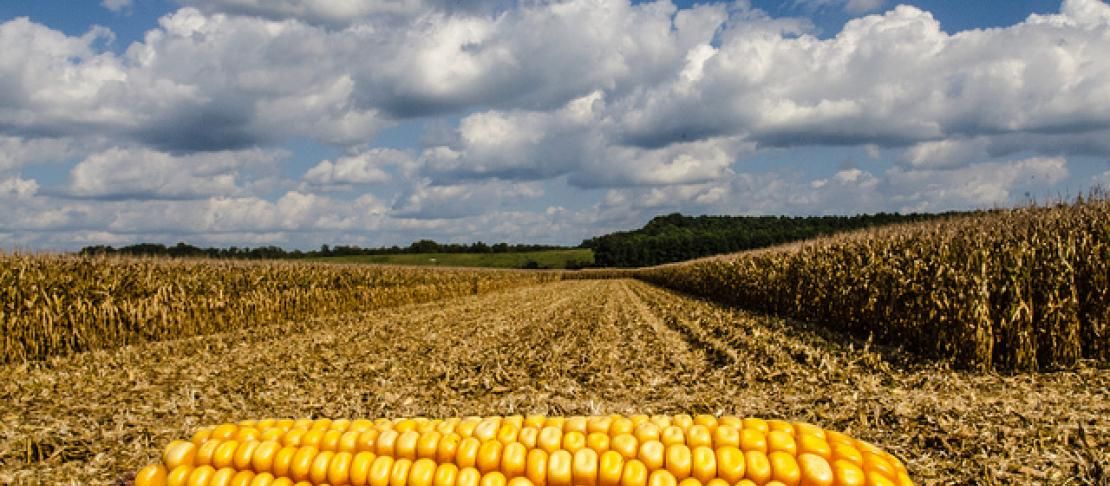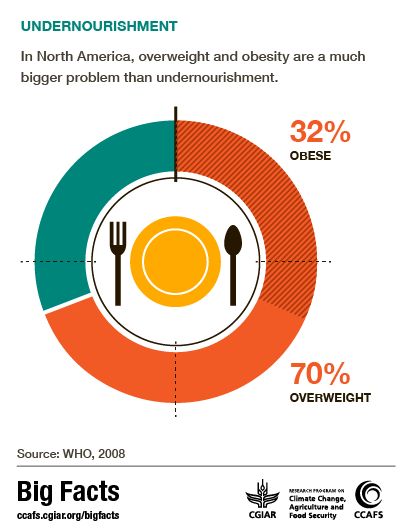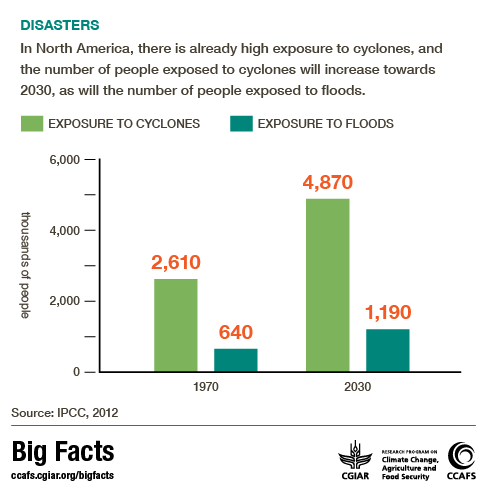Big Facts: Focus on North America

This story spotlights some of the Big Facts on climate change and food security in North America, and is part of a month-long series that complements the new Big Facts infographics website.
Of the focus regions on the Big Facts site, North America faces challenges that are in some ways a little different from the challenges faced by the low- and middle-income regions. Only Europe comes close to the same levels of food overconsumption, for example. Climate change will have profound impacts, and weather-related events (such as hurricanes) which have always had a large impact on North America, will only get worse.
Food Security – overconsumption is the real problem
 In North America, overconsumption is the main food security-related problem: more than two thirds [67.1-71.8%] of all American adults are overweight. The US is not alone with this problem, as the prevalence of overweight people in US, Canada and Mexico is above 60%. Obesity, defined as having a Body Mass Index (weight to height squared ratio) of above 30, is also prevalent. In the US, almost one-third [29.5-34.3%], of all adults are obese (WHO, n.d.W)
In North America, overconsumption is the main food security-related problem: more than two thirds [67.1-71.8%] of all American adults are overweight. The US is not alone with this problem, as the prevalence of overweight people in US, Canada and Mexico is above 60%. Obesity, defined as having a Body Mass Index (weight to height squared ratio) of above 30, is also prevalent. In the US, almost one-third [29.5-34.3%], of all adults are obese (WHO, n.d.W)
The projected annual average population growth rate for the United States is in the range of 0.8-0.9% which is the highest among high-income countries, in part reflecting large immigration (USDA, 2011: 13), and the population of North America is expected to grow steadily towards 2100.
Slowing down emissions requires consumer action
 As in Europe (the other high-income region) the emissions from the food supply chain are substantial, especially in the post-harvest stages. The total avoidable food waste in the United States is estimated to be 55 million tonnes per year for 2009, which amounts to 28.7% of total annual production by weight (Venkat 2011). This waste results in GHG emissions of more than 113 CO2e per year, which is 13% of total national food-related emissions and 2% of total US GHG emissions (Vermeulen et al, 2012: 202 after Venkat, 2011).
As in Europe (the other high-income region) the emissions from the food supply chain are substantial, especially in the post-harvest stages. The total avoidable food waste in the United States is estimated to be 55 million tonnes per year for 2009, which amounts to 28.7% of total annual production by weight (Venkat 2011). This waste results in GHG emissions of more than 113 CO2e per year, which is 13% of total national food-related emissions and 2% of total US GHG emissions (Vermeulen et al, 2012: 202 after Venkat, 2011).
Impacts on People – climate change already hitting home
Weather and climate-related events are already affecting people in North America. From the 1995 Chicago heatwave to the recent superstorm Sandy in 2012, these events have caused property damage and loss of life. Field et al. (2007) note that without increased investments in countermeasures, hot temperatures and extreme weather are likely to cause increased adverse health impacts from heat-related mortality, pollution, storm-related fatalities and injuries, and infectious diseases.
Besides these impacts, research highlighted in the Intergovernmental Panel on Climate Change 2007-report (IPCC, 2007: 632), finds that people in northern Canada and Alaska are expected to experience the most disruptive impacts of climate change in the region, as climate change will induce shifts in the range or abundance of wild species crucial to the life and well-being of these indigenous peoples, seriously impacting their livelihood.
Reducing climate impacts on crops
A number of adaptation measures could help safeguard crops and forests in North America from severe climate change impacts. To protect against the effects of drought and changes in precipitation, it will be necessary to diversify crops, adopt water conserving measures, and develop (through breeding) disease- and drought resistant crop and livestock species. For planted forests and tree plantations, species and genotypes can be selected based on expected future climates. Planting a mix of tree species and maintaining an uneven age structure can increase resistance or resilience. For all types of forests, managing invasive species or improving post-disturbance phases, such as revegetation and restoration, is important for climate adaptation (Locatelli et al. 2008).
Reducing emissions in the food system
 The agricultural sector can also reduce its emissions through manure management, reduced tillage, grass plantings, and afforestation of agricultural land (Smith et al, 2007: 524). In high-intensity agriculture, which is the dominant agricultural form in North America, measures such a precision-agriculture (where crops are fertilized with the precise amount of nitrogen required), can also reduce emissions. Improved feeding practices can also lower the emissions from livestock, a sector that contributes significantly to agricultural emissions in North America.
The agricultural sector can also reduce its emissions through manure management, reduced tillage, grass plantings, and afforestation of agricultural land (Smith et al, 2007: 524). In high-intensity agriculture, which is the dominant agricultural form in North America, measures such a precision-agriculture (where crops are fertilized with the precise amount of nitrogen required), can also reduce emissions. Improved feeding practices can also lower the emissions from livestock, a sector that contributes significantly to agricultural emissions in North America.
Have your say
What will it take for North America to reduce its emissions from agriculture and food waste, and make its agriculture more resilient? Leave your ideas in the comments section below!
Now you can get all the Big Facts on the links between climate change, agriculture and food security at ccafs.cgiar.org/bigfacts2014. The new site features over 100 stunning infographics that illustrate the most up-to-date, thoroughly researched information on these topics.
Big Facts is also an open-access resource. You can download and share the graphics with your friends and colleagues and use them in your presentations and reports. Please do not hesitate to send us any suggestions for improvements, either by commenting below or sending us an email.
This story is part of a series focusing on the Big Facts on various topics and in different regions; join the conversation at ccafs.cgiar.org/blog and on twitter using #bigfacts

